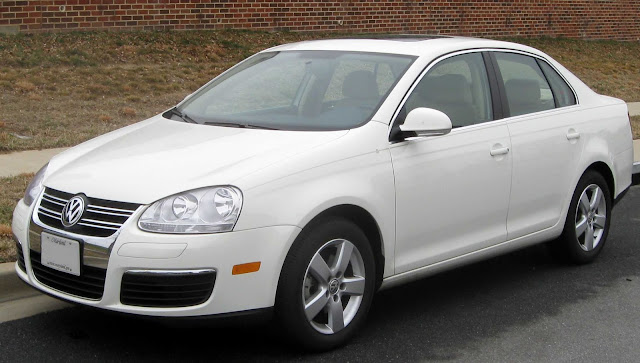The Volkswagen Jetta (About this sound listen (help·info)) is a small family car produced by the German manufacturer Volkswagen since 1979. Positioned to fill a sedan niche above the firm's Golf hatchback offering, it has been marketed over six generations variously as the Atlantic, Fox, Vento, Bora, City Jetta, Jetta City, GLI, Jetta, Clasico, Voyage, and Sagitar.
The Jetta was originally adapted by adding a conventional trunk to the Golf hatchback, and some distinctive styling (usually the front end, and sometimes slight interior changes). It has been offered in two- and four-door saloon (sedan), and five-door station wagon versions - all as four or five-seaters. Since the original version in 1980, the car has grown in size and power with each successive generation.[1] By mid-2011, almost 10 million Jettas have been produced and sold all over the world. As of April 2014, over 14 million had been sold with the car becoming Volkswagen's top selling model.
Though numerous sources suggest the Jetta nameplate derives from the Atlantic 'jet stream' during a period when Volkswagen named its vehicles after prominent winds and currents (e.g., the Volkswagen Passat (after the German word for trade wind), Volkswagen Bora (after bora), and Volkswagen Scirocco (after sirocco), a 2013 report by former VW advertising copywriter Bertel Schmitt, says that — after consulting knowledgeable VW sources including Dr. Carl Hahn, former Volkswagen of America Chief and WP Schmidt, former sales chief at Volkswagen — no conclusive evidence suggests that Volkswagen employed a naming theme for its then new front-drive, water-cooled vehicles; nor that the names trace etymologically to any particular theme; nor that any naming system "was ever announced, either officially or confidentially
Although the Golf had reached considerable success in the North American markets, Volkswagen observed that the hatchback body style lacked some of the appeal to those who preferred the traditional three-box configuration. The styling of the 1970 AMC Gremlin was controversial for truncating the Hornet sedan, but Volkswagen stylists reversed the process by essentially grafting a new trunk onto the tail of the Golf to produce a larger Jetta saloon (sedan). The Jetta became the best-selling European car in the United States, Canada, and México. The car is also popular in Europe, including the United Kingdom, Germany, and Turkey.
The Jetta was introduced to the world at the 1979 Frankfurt Auto Show. Production of the first generation began in August 1979 at the Wolfsburg plant. In México, the Mark 1 was known as the "Volkswagen Atlantic".
The car was available as a two-door sedan (replacing the aging rear-engined, rear-wheel drive Volkswagen Beetle 2-door sedan in the United States and Canada) and four-door sedan body styles, both of which shared a traditional three-box design. Like the Volkswagen Golf Mk1, its angular styling was penned at ItalDesign, by Giorgetto Giugiaro. Styling differences could be found depending on the market. In most of the world, the car was available with composite headlamps, while in the USA, it was only available with rectangular sealed beam lamps due to Federal Motor Vehicle Safety Standard 108 (FMVSS 108). The suspension setup was identical to the Golf and consisted of a MacPherson strut setup in front and a twist-beam rear suspension in the rear. It shared its 2.4 metre (94.5 in) wheelbase with its hatchback counterpart, although overall length was up by 380 millimetres (15 in). The capacity of the luggage compartment was 377 litres (13.3 ft3), making the Jetta reasonably practical.[15] To distinguish the car from the Golf, interiors were made more upscale in all markets.This included velour seating and color coordinated sill to sill carpeting.
Engine choices varied considerably depending on the local market. Most were based on 827 engines of the era. Choices in petrol engines ranged from a 1.1 litre four-cylinder engine producing 37 kilowatts (50 PS; 50 bhp), to a 1.8-litre I4 which made 82 kilowatts (111 PS; 110 bhp) and 150 newton metres (111 lbf·ft) of torque. Some cars were equipped with carburetors, while others were fuel-injected using K or KE Jetronic supplied by Robert Bosch GmbH. Diesel engine choices included a 1.6-litre making 37 kilowatts (50 PS; 50 bhp) and a turbocharged version of the same engine which produced 51 kilowatts (69 PS; 68 bhp) and 130 newton metres (96 lbf·ft) of torque.



















0 nhận xét:
Đăng nhận xét